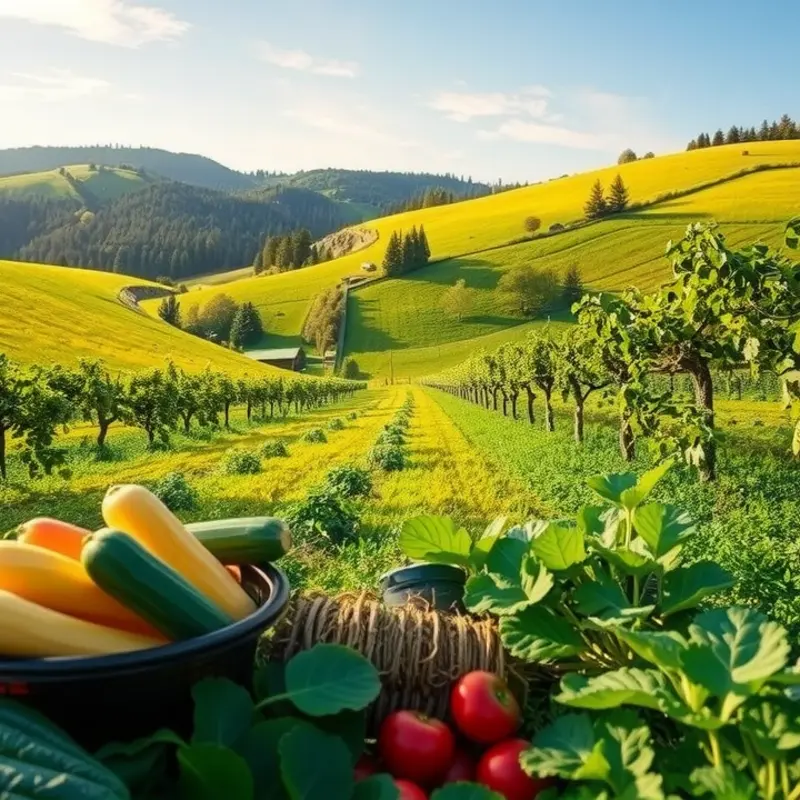Adopting food rotation practices not only elevates your culinary experience but also significantly contributes to ecological health. By strategically varying your food choices and sources, you cultivate a more sustainable and vibrant food system. This article dives into the ecological benefits of food rotation, empowering you to make informed choices that support both your health and the planet’s wellbeing.
The Power of Biodiversity: Why Variety Matters

Altering what we plant and consume plays a vital role in supporting biodiversity and a balanced ecosystem. Biodiversity provides resilience to environmental pressures, ensuring that ecosystems thrive even amid adversity. By rotating crops and diversifying diets, we can foster a sustainable agricultural system that benefits all forms of life.
Enhancing Soil Health with Diverse Planting
Biodiversity below ground is as crucial as it is above. Various plant species contribute different nutrients and organic matter back into the soil. For example, legumes fix nitrogen, enriching the soil for subsequent crops. This diversity enables a more dynamic and nutrient-rich soil environment, supporting healthier plants, reducing the need for synthetic fertilizers.
Reducing Pest Outbreaks Naturally
A monoculture environment often invites pest infestations, as pests thrive in uniform settings. Diverse plantings can disrupt pest life cycles and habitats, naturally minimizing outbreaks. For instance, introducing a variety of crops instead of a single type breaks pest propagation, thus reducing the dependency on chemical pesticides.
Strengthening Food Systems through Diversity
A diversified cropping system creates more resilient food systems. This diversity safeguards food supply against disease and variable climate conditions. For instance, while a blight might devastate one crop variety, others may be resistant, ensuring that some portion of the food supply remains intact. Disease resistance is central to maintaining food security, particularly as climate change brings unpredictability.
Promoting Environmental Harmony and Balance
Variety in plant life encourages a balanced ecosystem, supporting pollinators and beneficial organisms. Pollinators such as bees are crucial to growing many crops. Ensuring a variety of flowering plants means more consistent food sources for these important creatures. A thriving pollinator population contributes to the health and productivity of an ecosystem, creating a positive feedback loop.
Consuming with Curiosity
Expanding our dietary habits to include underutilized plant species can further support ecological balance. Many traditional crops have the potential to offer significant nutritional benefits while requiring fewer resources. By being adventurous in our consumption habits, we can support farmers who are integrating sustainable practices into their operations.
For those interested in exploring how to integrate a diversity of foods into their diets while maintaining a balanced, nutritional intake, understanding the basics of nutritional adequacy could be beneficial. For more information, you might find this guide on nutritional adequacy useful.
By embracing biodiversity on our plates and in our fields, we support a healthier planet. Encouraging a variety of plant life helps maintain the delicate balance of our ecosystems, making them more resilient. The choices we make today in planting and eating can sow the seeds for a more sustainable tomorrow.
Soil Health: Your Foundation for Sustainable Eating

Healthy soil is more than just dirt beneath our feet. It’s a dynamic ecosystem teeming with life. Rich in organic matter, healthy soil is the bedrock of sustainable agriculture. By rotating crops, we can significantly improve soil structure and fertility, reduce erosion, and nurture essential microorganisms.
Crop rotation, an age-old agricultural technique, plays a vital role in maintaining soil health. It involves the strategic planting of different crops in a sequence over several seasons. This practice prevents the depletion of specific nutrients and disrupts the cycles of pests and diseases. For instance, planting legumes enriches the soil with nitrogen, which is essential for subsequent crops like corn or wheat.
By rotating crops with varied root structures, farmers naturally enhance soil structure. Deep-rooted plants, such as alfalfa, break up compacted soil layers, improving aeration and water infiltration. Shallow-rooted crops stabilize the topsoil, minimizing erosion. This two-pronged approach ensures a balanced distribution of soil resources.
Microorganisms are the unsung heroes of healthy soil. They decompose organic matter, releasing nutrients that plants can absorb. Rotation fosters a diverse microbial environment by ensuring no single crop dominates the field for too long. This diversity supports the resilience of the soil against pests and diseases.
Incorporating cover crops into the rotation strategy further boosts soil health. These crops, which are grown primarily to protect and enrich the soil rather than for harvest, prevent erosion and enhance organic matter content. Rye, clover, and radishes are popular cover crops that also improve soil moisture retention and suppress weeds.
For home gardeners, implementing crop rotation can improve the health of their soils and the quality of their produce. A simple practice is to follow a three-year rotation plan with leafy greens, root vegetables, and legumes. This approach mimics nature’s diversity, fostering a vibrant ecosystem in the backyard.
Beyond individual gardens, the principles of soil health can extend to broader sustainable eating practices. Mindful consumption and understanding the sources of our food go hand in hand with agricultural sustainability. Incorporating a variety of ingredients into our diets encourages agricultural diversity, reducing demand for monocultures that deplete soil health.
To learn more about crafting a mindful and eco-friendly approach to your food preparation and storage, visit eco-smart kitchen storage. It’s one more step toward building a sustainable lifestyle, benefiting personal health and the environment.
Through crop and diet diversity, we can revitalize our plates and promote a healthier planet, all rooted in the vibrant life of healthy soil.
Final words
Food rotation is a simple yet powerful way to enhance biodiversity and improve soil health, ensuring a sustainable future for our planet. By incorporating diverse food choices in your diet, you not only support healthy ecosystems but also enjoy richer flavors and nutritional benefits. As environmentally-conscious consumers, embracing food rotation practices aligns your dietary habits with ecological sustainability, creating a positive impact for generations to come. Start today, and be part of the solution for a healthier Earth!








